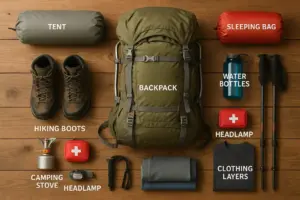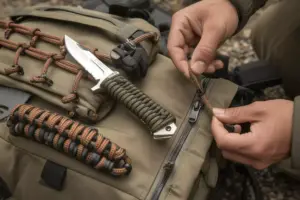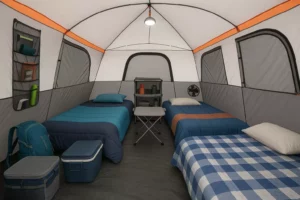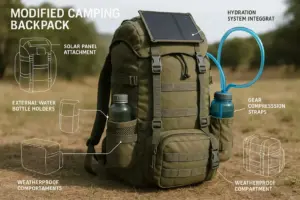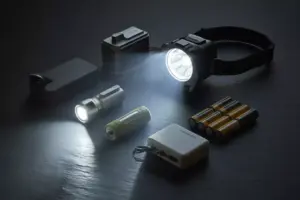Don’t Overspend: The Best Cheap & Light 1-Person Tents of 2025
Picture this: you’re standing at the trailhead at dawn, watching other hikers struggle with massive backpacks while you effortlessly shoulder your lightweight gear. The secret? A carefully chosen ultralight tent that didn’t break the bank. In 2025’s competitive outdoor gear market, finding the perfect balance between affordability, weight, and quality has never been more achievable for solo adventurers.
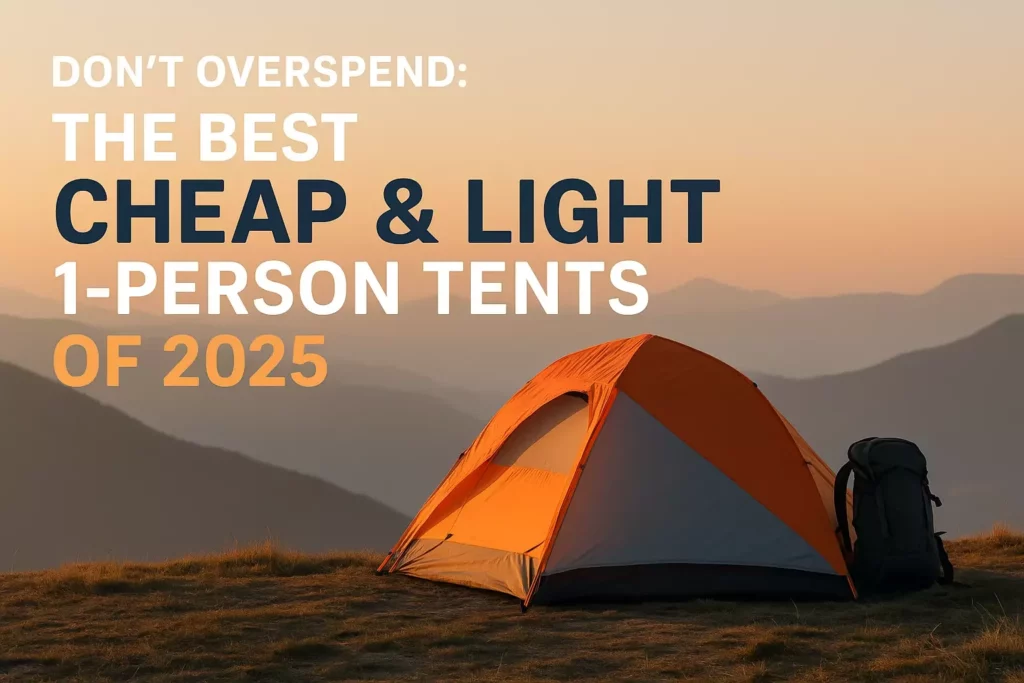
Gone are the days when lightweight meant expensive. Today’s budget-conscious backpackers can access tent technology that was once reserved for premium brands, thanks to innovative materials and manufacturing processes that have democratized ultralight camping gear.
Key Takeaways
- Weight matters most: Look for tents under 3 pounds for backpacking, with many quality options available under 2.5 pounds
- Budget sweet spot: Excellent 1-person tents can be found in the $80-$200 range without sacrificing essential features
- Three-season focus: Most budget ultralight tents excel in spring, summer, and fall conditions rather than extreme winter camping
- Setup simplicity: Trekking pole tents offer the best weight-to-space ratio and eliminate extra tent pole weight
- Durability vs. weight trade-off: Understanding material choices helps balance longevity with pack weight for your specific needs
Why Choose a 1-Person Tent? 🎒
Solo camping has surged in popularity, and for good reason. One-person tents offer unmatched freedom, allowing adventurers to move quickly, camp in smaller spaces, and enjoy the solitude that many seek in the wilderness. Unlike larger tents, these shelters prioritize efficiency over luxury, making them ideal for backpacking, bikepacking, and minimalist camping.
The weight savings are substantial. While a typical 2-person tent might weigh 4-6 pounds, quality 1-person tents often clock in at 2-3 pounds or less. This difference becomes crucial when every ounce matters on long-distance hikes or multi-day adventures.
Space efficiency is another major advantage. Solo tents fit into campsites where larger tents simply won’t work – think narrow ledges, small clearings, or established backcountry sites with limited flat ground.
Understanding Tent Weight Categories
Before diving into specific recommendations, it’s essential to understand how tent weights are categorized and what those numbers mean for your camping experience.
Ultralight (Under 2 lbs)
These tents represent the cutting edge of lightweight design, often using premium materials like Dyneema fabric and carbon fiber components. While traditionally expensive, several budget options now exist in this category.
Lightweight (2-3 lbs)
The sweet spot for most backpackers, offering excellent portability without extreme compromises in durability or comfort.
Standard Backpacking (3-4 lbs)
Still suitable for backpacking but better for shorter trips or when weight isn’t the primary concern.
Essential Features to Consider
Packed Weight vs. Trail Weight
Always check the trail weight – the actual weight you’ll carry, including tent body, rainfly, stakes, and guylines. Packed weight often excludes essential components and can be misleading.
Floor Space and Livability
Most 1-person tents offer 17-25 square feet of floor space. Consider your height, gear storage needs, and comfort preferences when evaluating dimensions.
Weather Protection
Look for tents with:
- Waterproof ratings of at least 1500mm for the floor
- Breathable fabrics to minimize condensation
- Strong pole systems that can handle wind gusts
- Proper ventilation with multiple vents or mesh panels
Setup Complexity
Simple setups save time and frustration, especially in poor weather. Trekking pole tents eliminate pole weight but require compatible hiking poles.
Top Budget-Friendly Ultralight 1-Person Tents for 2025
Best Overall Value: Naturehike Cloud-Up 1
Weight: 2.2 lbs | Price Range: $90-120
This tent has revolutionized the budget ultralight market. The Cloud-Up 1 offers genuine 3-season protection with a spacious interior and reliable construction. Its double-wall design minimizes condensation, while the aluminum poles provide excellent stability.
Pros:
- Excellent build quality for the price
- Spacious vestibule for gear storage
- Easy setup with color-coded poles
- Good ventilation system
Cons:
- Slightly heavier than premium options
- Condensation can be an issue in humid conditions
Best Trekking Pole Tent: Lanshan 1 Pro
Weight: 1.9 lbs | Price Range: $85-110
For hikers who already carry trekking poles, the Lanshan 1 Pro offers exceptional value. This single-wall tent uses your trekking poles for support, creating a surprisingly spacious interior for its weight.
Pros:
- Ultra-lightweight design
- Large interior space
- Excellent value proposition
- Quick setup once mastered
Cons:
- Requires trekking poles
- Single-wall design increases condensation risk
- Learning curve for initial setup
Best for Tall Hikers: River Country Products Trekker Tent 1
Weight: 2.4 lbs | Price Range: $130-160
Designed specifically for taller adventurers, this tent offers extra length without significant weight penalty. The robust construction handles weather well while maintaining affordability.
Pros:
- Extended length (90+ inches)
- Durable materials
- Good weather resistance
- Reasonable price point
Cons:
- Heavier than ultralight competitors
- Limited color options
- Smaller vestibule space
Material Science: Understanding Fabric Choices
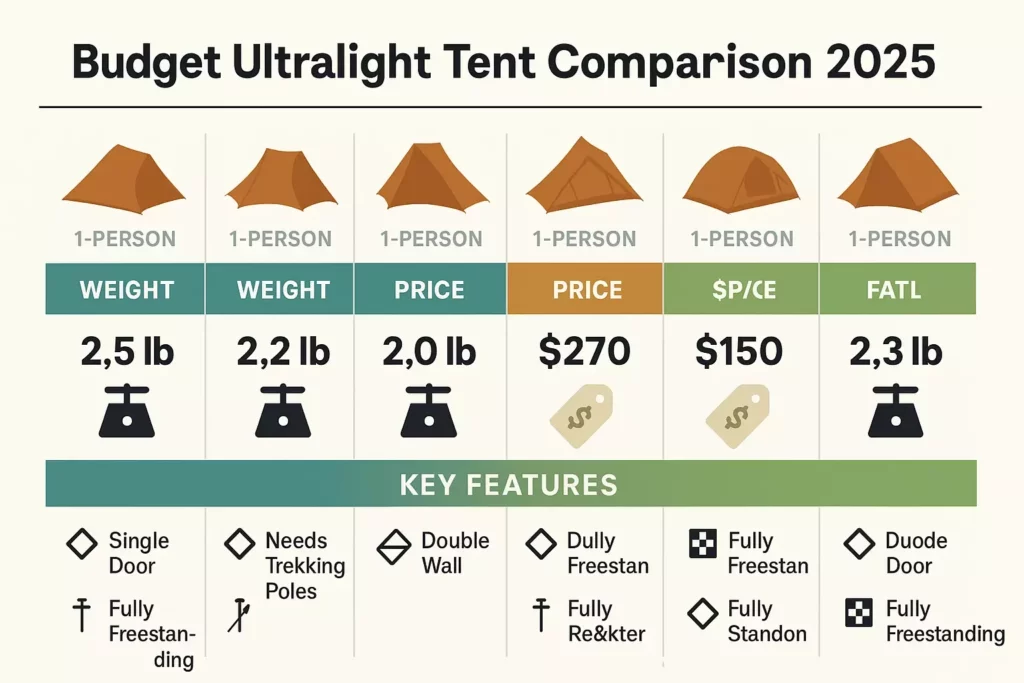
Modern tent fabrics represent a careful balance between weight, durability, and cost. Understanding these materials helps make informed decisions about long-term value.
Nylon vs. Polyester
Nylon dominates the ultralight market due to its superior strength-to-weight ratio. However, it stretches when wet and requires UV treatment to prevent degradation.
Polyester offers better UV resistance and doesn’t stretch when wet, but weighs more than comparable nylon fabrics.
Denier Ratings
Lower denier numbers indicate lighter, thinner fabrics. Most budget ultralight tents use 15D-30D fabrics, balancing weight savings with reasonable durability.
Waterproof Coatings
- PU (Polyurethane): Most common, affordable, adequate performance
- Silicone: Lighter, more durable, but more expensive
- PE (Polyethylene): Budget option, heavier but very waterproof
Setup Systems and Pole Configurations
The tent’s setup system significantly impacts both weight and ease of use. Understanding different approaches helps choose the right option for your camping style.
Traditional Pole Systems
Aluminum poles offer excellent strength and reliability. Look for DAC or similar quality pole manufacturers. These systems are heavier but provide the most stable setup and don’t require additional gear.
Trekking Pole Systems
Using trekking poles as tent supports eliminates pole weight entirely. However, this requires carrying appropriate poles and learning more complex setup procedures. For serious backpackers who already use trekking poles, this represents significant weight savings.
Hybrid Systems
Some tents combine short aluminum poles with trekking pole support, offering a middle ground between convenience and weight savings.
Seasonal Considerations and Weather Performance
Most budget ultralight tents excel in three-season conditions but have limitations in extreme weather. Understanding these boundaries prevents dangerous situations and extends tent lifespan.
Spring Camping
Expect variable weather and potential for unexpected storms. Look for tents with strong pole systems and full coverage rainflies. Ventilation becomes crucial as temperatures fluctuate.
Summer Adventures
Heat and humidity create condensation challenges. Prioritize tents with excellent ventilation, mesh panels, and breathable fabrics. UV resistance becomes important for extended exposure.
Fall Expeditions
Falling temperatures and increased precipitation demand reliable weather protection. Ensure your tent’s waterproof ratings can handle sustained rain and consider models with larger vestibules for gear protection.
When planning your camping adventures, having the right gear beyond just your tent is crucial. Consider building a comprehensive first aid kit and learning how to pack your backpack efficiently to maximize your outdoor experience.
Maintenance and Care Tips
Proper maintenance extends tent lifespan significantly, making budget options even more cost-effective over time.
Cleaning and Storage
- Always dry thoroughly before storage
- Clean with mild soap and water only
- Store loosely packed to prevent fabric damage
- Avoid machine washing unless specifically recommended
Field Repairs
Carry a basic repair kit including:
- Tent-specific patch material
- Seam sealer
- Duct tape for emergency repairs
- Spare stakes and guylines
Seam Maintenance
Reapply seam sealer annually or when leaks develop. This simple maintenance prevents major waterproofing failures and extends tent life significantly.
Budget-Conscious Shopping Strategies
Timing and research can dramatically reduce costs without compromising quality.
Best Times to Buy
- End of season sales (September-October)
- Pre-season clearances (February-March)
- Black Friday and outdoor retailer sales
- Manufacturer direct sales
Where to Shop
- Manufacturer websites for best selection
- Outdoor specialty retailers for expert advice
- Online marketplaces for competitive pricing
- Outdoor gear swaps for gently used options
What to Avoid
- Extremely cheap tents under $50 (usually poor quality)
- Tents without weight specifications
- Unknown brands without reviews or warranty support
- Tents claiming “4-season” capability at ultralight weights
Essential Accessories and Add-Ons
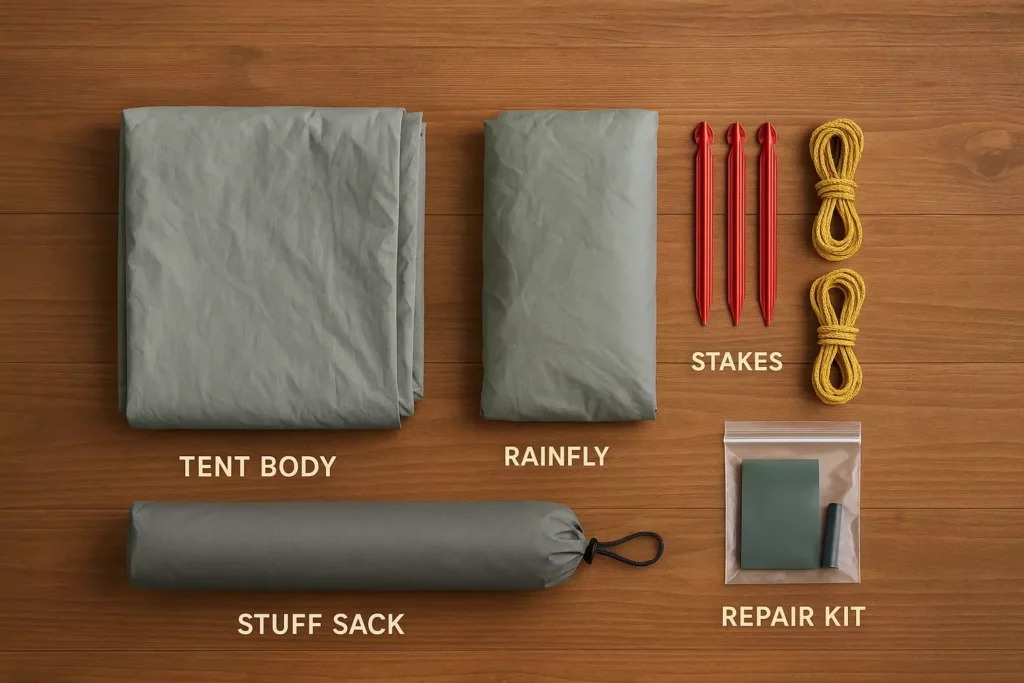
The right accessories enhance tent performance without adding significant weight or cost.
Footprints and Ground Protection
While many ultralight enthusiasts skip footprints to save weight, they significantly extend tent floor life. Consider lightweight alternatives like Polycro or Tyvek for custom solutions.
Stake Upgrades
Tent stakes dramatically impact setup reliability. Titanium stakes offer weight savings, while aluminum Y-stakes provide better holding power in various soil conditions.
Guyline Optimization
Reflective guylines improve nighttime visibility and safety. Adjustable tensioners allow fine-tuning for optimal setup in varying conditions.
For colder weather camping, understanding proper clothing choices and sleeping bag selection becomes crucial for safety and comfort.
Real-World Performance Testing
Understanding how tents perform in actual field conditions helps set realistic expectations and choose appropriate models for specific use cases.
Wind Resistance
Most budget ultralight tents handle winds up to 25-30 mph effectively when properly staked and guyed out. Higher winds require more robust (and heavier) designs or alternative shelter strategies.
Rain Performance
Quality budget tents typically handle moderate to heavy rain well, but prolonged storms may reveal weaknesses in cheaper waterproof coatings or seam construction.
Condensation Management
Single-wall tents inherently produce more condensation than double-wall designs. Proper ventilation techniques and campsite selection become crucial for comfort.
Advanced Tips for Ultralight Camping
Experienced ultralight campers employ various strategies to maximize tent performance while minimizing weight and bulk.
Site Selection
Choosing appropriate campsites reduces stress on lightweight tents and improves comfort. Look for:
- Natural wind protection
- Level ground to minimize stake stress
- Good drainage to prevent water accumulation
- Appropriate clearance for guylines
Setup Techniques
Proper setup maximizes tent performance and longevity:
- Stake corners first for proper tension
- Adjust guylines for optimal stability
- Ensure adequate but not excessive tension
- Use all attachment points for maximum strength
Weather Monitoring
Lightweight tents require more weather awareness than robust car camping shelters. Modern weather apps and basic meteorology knowledge help avoid dangerous situations.
Comparison with Premium Options
Understanding what you gain and lose compared to premium tents helps make informed decisions about value and performance trade-offs.
Material Quality
Premium tents often use proprietary fabrics like Dyneema or advanced nylon blends that offer better durability and weather resistance. Budget options use standard materials that perform adequately but may show wear sooner.
Construction Details
Higher-end tents feature refined details like taped seams, reinforced stress points, and precision manufacturing. Budget tents may require more careful handling and maintenance.
Warranty and Support
Premium brands typically offer better warranty coverage and customer support, while budget manufacturers may provide limited support or shorter warranty periods.
When planning extended camping trips, consider learning about water purification methods and bushcraft survival skills to enhance your outdoor self-sufficiency.
Common Mistakes to Avoid
Learning from common errors saves money and improves camping experiences.
Buying Too Light Too Soon
New backpackers often prioritize weight over durability, leading to gear failures and safety issues. Start with slightly heavier, more robust options and upgrade as experience grows.
Ignoring Setup Complexity
Complex tents become frustrating in poor weather or low light. Practice setup at home and consider ease of use in your decision-making process.
Overlooking Repair Costs
Factor potential repair and replacement costs into your budget. Sometimes spending slightly more upfront saves money long-term.
Misunderstanding Weight Ratings
Always verify actual packed weight and included components. Marketing weights often exclude essential items like stakes and guylines.
🏕️ Find Your Perfect 1-Person Tent
Filter by your preferences to find the best budget ultralight tent for your needs
Future Trends in Ultralight Tent Design
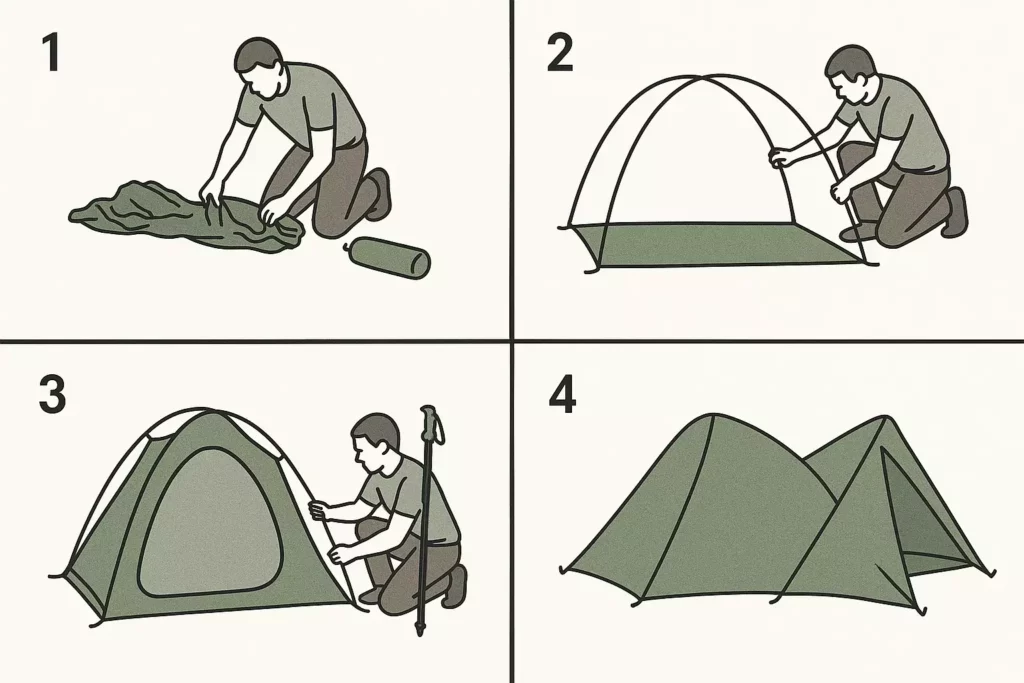
The outdoor industry continues evolving rapidly, with 2025 bringing exciting developments in materials and design philosophy.
Sustainable Materials
Manufacturers increasingly focus on recycled and bio-based materials without compromising performance. These innovations may initially cost more but represent the industry’s future direction.
Modular Designs
Some brands experiment with modular tent systems allowing customization for specific trips. While currently premium-priced, these concepts may filter down to budget segments.
Smart Integration
Basic electronic integration like LED lighting and USB charging ports appears in some budget tents, though weight-conscious backpackers may prefer separate solutions.
Building Your Complete Lightweight Kit
A great tent is just one component of an effective ultralight system. Consider how your shelter choice integrates with other gear decisions.
Sleep System Integration
Your tent choice affects sleeping bag and pad selection. Smaller tents may require more compact sleep systems, while larger shelters offer more flexibility.
Cooking and Storage
Vestibule size impacts cooking options and gear storage strategies. Plan your complete kit to work together effectively.
For those interested in expanding their camping experiences, consider exploring family camping options or learning about campfire cooking techniques to enhance your outdoor adventures.
Regional Considerations
Different geographic regions present unique challenges that influence tent selection.
Mountain Environments
High altitude camping demands excellent wind resistance and UV protection. Consider tents with robust pole systems and proven high-altitude performance.
Desert Camping
Hot, dry conditions prioritize ventilation and UV resistance over maximum waterproofing. Single-wall tents may work well in low-humidity environments.
Coastal Areas
Salt air and high humidity require excellent corrosion resistance and ventilation. Rinse gear thoroughly after coastal use to prevent damage.
Forest Camping
Dense vegetation may limit setup options, favoring compact tents with flexible guy-line configurations.
Long-Term Value Assessment
Evaluating long-term value requires considering factors beyond initial purchase price.
Cost Per Use
Calculate potential cost per camping night over the tent’s expected lifespan. A $150 tent used 30 times costs $5 per use, while a $300 tent used 100 times costs $3 per use.
Resale Value
Quality tents from reputable manufacturers retain value better than unknown brands. Consider potential resale when upgrading gear.
Repair vs. Replace
Factor repair costs and availability into your decision. Some manufacturers offer excellent repair services, while others expect replacement after damage.
Safety Considerations
Ultralight camping requires heightened safety awareness due to reduced gear margins and potential isolation.
Weather Limits
Understand your tent’s limitations and have backup plans for severe weather. Lightweight shelters may require alternative strategies in extreme conditions.
Emergency Preparedness
Carry appropriate emergency gear and communication devices. Weight savings shouldn’t compromise basic safety requirements.
Skill Development
Practice setup procedures and emergency repairs before heading into remote areas. Ultralight gear often requires more skill to use effectively.
Conclusion
Finding the perfect balance between cost, weight, and performance in a 1-person tent has never been more achievable than in 2025. The market offers genuine ultralight options under $200 that would have cost twice as much just a few years ago. Whether you choose a freestanding tent like the Naturehike Cloud-Up 1 for its ease of use, or embrace the weight savings of a trekking pole tent like the Lanshan 1 Pro, success depends on understanding your specific needs and priorities.
Remember that the best tent is the one that matches your camping style, budget, and experience level. Start with a reliable, slightly heavier option if you’re new to ultralight camping, then upgrade as your skills and needs evolve. The weight savings and freedom that come with a well-chosen ultralight shelter will transform your outdoor adventures, opening up new possibilities for exploration and solitude in the wilderness.
Next Steps:
- Assess your camping style and typical weather conditions
- Set a realistic budget that includes accessories and maintenance
- Research specific models using the criteria outlined in this guide
- Read recent user reviews from actual backpackers
- Practice setup before your first backcountry trip
- Start with shorter trips to test your gear system
The trail awaits, and with the right lightweight shelter, you’ll be ready to explore it with confidence and comfort.

